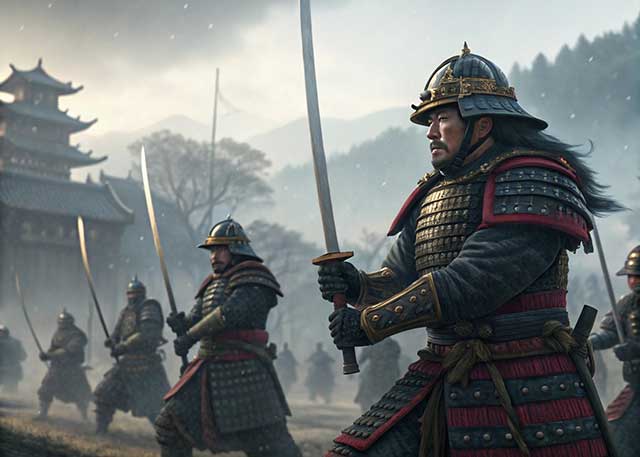
The Battle of Norada is a striking example of a clash during the Sengoku Jidai period, when numerical superiority did not always guarantee victory, even in open battle.
The Rokkaku clan was one of the most influential families in the province of Omi, dating back to the 13th century. Its representatives held the posts of military governors (shugo) in various provinces at different times. The Azai (or Asai) clan emerged in the early 16th century. During the gokoku-jo (the lower classes overthrowing the upper classes) process typical of the era, the Asai freed themselves from vassalage to the Kyogoku clan and established control over the northeastern part of Omi. However, their lands were soon captured by the Rokkaku, and the Asai clan had to submit. Despite this, the Azai leaders continued to fight for independence, which led to a series of armed clashes with the Rokkaku.
In 1559, the head of the Rokkaku clan, Rokkaku Yoshitaka (1521–1598), formally became a monk and handed over leadership of the clan to his son, Rokkaku Yoshisuke. However, real power remained in the hands of Yoshitaka, who continued to command the army.
In the summer of 1560, Yoshitaka launched a military campaign against the Azai, gathering an army of about 25,000 men (according to the Azai Sandai chronicle). The main target was Hida Castle, which had not been captured the previous year.
The Rokkaku army consisted of troops from various subordinate clans. The vanguard was made up of warriors from the Gamo, Nagahara, Shindo, and Ikeda clans. The second line was formed by the forces of Narazaki, Tanaka, Kido, Wada, Yoshida, and others, while the rear was occupied by troops from the Goto, Miura, Yamada, Tazaki, and other clans.
The formal head of the Azai clan at that time was Azai Hisamasa (1526–1573), but his weakness as a leader caused discontent among his vassals. The real leadership of the army was taken over by his fifteen-year-old son, Azai Nagamasa (1545–1573), who enjoyed the support of most of the soldiers.
The Azai clan, with the support of its allies and vassals—the Dodo, Isono, Yono, Imamura, Yuge, Hongo, and other clans—was able to field about 11,000 soldiers. The allied Asakura clan sent reinforcements, but its troops arrived after the battle had already ended.
The battle took place near the Usogawa River, which is why it is sometimes called the “Battle of Usogawa.”
The first strike was delivered by Dodo Kuranosuke, a former vassal of Rokkaku who had defected to Azai. His troops crossed the river and engaged in battle with the forces of the Gamo clan. However, the forces of the Narazaki and Tanaka clans attacked them from the flanks. Kuranosuke was killed, and Dodo's troops retreated across the river.
Inspired by their success, the Rokkaku troops crossed the Usogawa River and marched towards the village of Norada, hoping for a quick victory.
But Nagamasa did not give in to panic. He gave a fiery speech to his soldiers, raising their morale, and led the attack. The elite forces of Azai stood in the center, with allied troops covering the flanks. The strike was swift and powerful—despite their numerical superiority, the Rokkaku army could not withstand the pressure, and panic broke out in their ranks, turning into a mass retreat. The chronicles note that “the Usogawa River was littered with the bodies of fallen warriors.”
According to various sources, the Rokkaku suffered between 840 and 920 casualties, while the Azai lost between 400 and 700 fighters.
After this brilliant victory, Azai Nagamasa was officially recognized as the clan's daimyo. The defeat was a heavy blow to the Rokkaku clan, which never recovered and ceased to exist by 1570.
See also
-
The Siege of Hara Castle

The Shimabara Rebellion of 1637–1638, which culminated in the siege of Hara Castle, was the last major uprising of the Edo period and had serious political consequences.
-
Battle of Tennoji

The confrontation between Tokugawa Ieyasu and Toyotomi Hideyori during the “Osaka Winter Campaign” ended with the signing of a peace treaty. On January 22, 1615, the day after the treaty was signed, Ieyasu pretended to disband his army. In reality, this meant that the Shimazu forces withdrew to the nearest port. On the same day, almost the entire Tokugawa army began filling in the outer moat.
-
Siege of Shuri Castle

The Ryukyu Kingdom was established in 1429 on Okinawa, the largest island of the Ryukyu (Nansei) archipelago, as a result of the military unification of three rival kingdoms. In the following years, the state's control spread to all the islands of the archipelago.
-
The Siege of Fushimi Castle
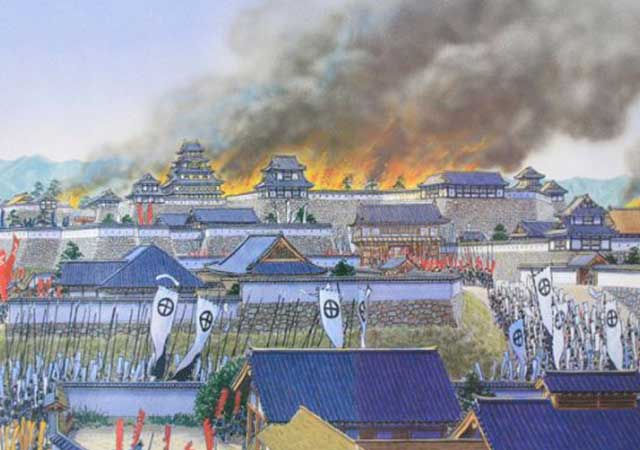
Fushimi can perhaps be considered one of the most “unfortunate” castles of the Sengoku Jidai period. The original castle was built by Toyotomi Hideyoshi in the southeast of Kyoto in 1594 as his residence in the imperial city.
-
The Siege of Otsu Castle
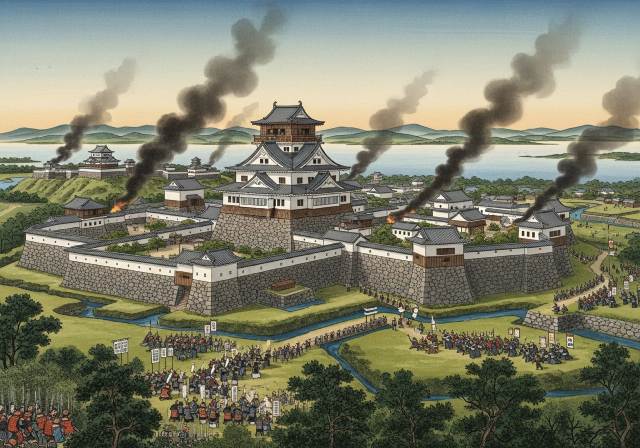
The siege of Otsu Castle was part of the Sekigahara campaign, during which the so-called Eastern Coalition, led by Tokugawa Ieyasu, fought against the Western Coalition, led by Ishida Mitsunari. Otsu Castle was built in 1586 by order of Toyotomi Hideyoshi near the capital Kyoto, on the site of the dismantled Sakamoto Castle. It belonged to the type of “water castles” — mizujō — as one side of it faced Japan's largest lake, Lake Biwa, and it was surrounded by a system of moats filled with lake water, which made the fortress resemble an island.
-
The Siege of Shiroishi Castle
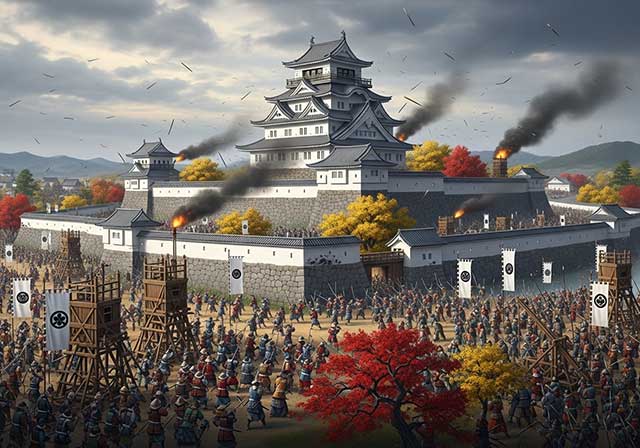
The siege of Shiroishi Castle was part of the Sekigahara campaign and took place several months before the decisive battle of Sekigahara. The daimyo of Aizu Province, Uesugi Kagekatsu, posed a serious threat to Tokugawa Ieyasu's plans to defeat the Western Coalition, and Ieyasu decided to curb his actions with the help of his northern vassals. To this end, he ordered Date Masamune to invade the province of Aizu and capture Shiroishi Castle.
-
The Second Siege of Jinju Castle
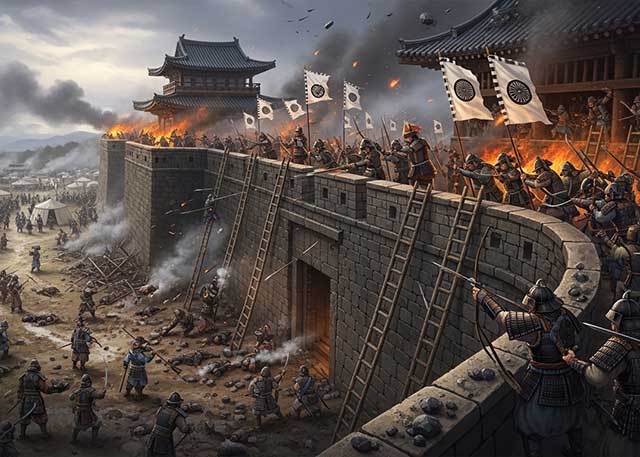
During the two Korean campaigns of the 16th century, the Japanese repeatedly had to capture enemy fortresses and defend occupied or constructed fortifications from the combined Korean and Chinese forces. Among all the operations of that time, the second siege of Jinju Castle is considered the most interesting from the point of view of siege warfare.
-
The Siege of Takamatsu Castle
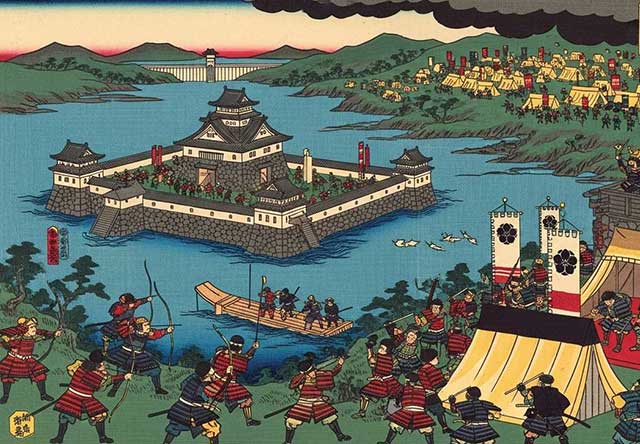
The siege of Takamatsu Castle in Bitchu Province is considered the first mizuzeme, or “water siege,” in Japanese history. Until then, such an original tactic had never been used.

